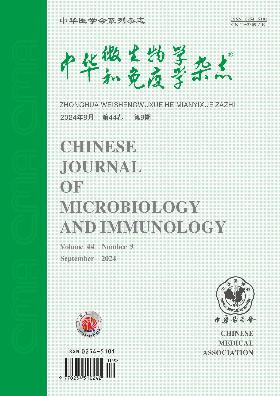食源性和环境样品中分离的洞穴气单胞菌的系统发育特征、毒力和抗生素耐药性
Q4 Immunology and Microbiology
引用次数: 0
摘要
目的从食源性和环境样品中分离49株鱼穴气单胞菌,并对其毒力和耐药性进行分析。方法采用VITEK和API 20NE对所有菌株进行鉴定。用PCR扩增出两个持家基因gryB和rpoD进行系统发育分析。PCR检测毒力基因act、alt、ast、lip、ahp、aerA、hlyA、ompA1和fla。采用AST-GN16试剂盒检测各菌株的体外药敏。结果经生化试验鉴定出54株鼠腔气单胞菌/嗜水气单胞菌。系统发育分析显示,共有49株鱼子鱼气单胞菌、4株嗜水气单胞菌和1株台湾气单胞菌。alt、lip、ompA1、fla、act、aerA和hlyA基因阳性率分别为100.00%、100.00%、79.59%、14.29%、2.04%、2.04%和2.04%。所有分离株均未携带ast或ahp基因。共检测到4种毒力基因组合模式,优势组合为alt/lip/ompA1(32/49)。鱼穴气单胞菌对氨苄西林、头孢唑林、头孢西丁、阿莫西林/克拉维酸、头孢曲松、甲氧苄啶/磺胺、甲恶唑和氨曲南的耐药率分别为79.59%、14.29%、10.20%、6.12%、4.08%、4.08%和2.04%。所有菌株对哌拉西林/他唑巴坦、亚胺培南、阿米卡星、庆大霉素、左氧氟沙星、替加环素和呋喃妥因均敏感。检出2株多重耐药菌株。结论内务基因gyrB和rpoD可以有效地鉴定出鼠腔气单胞菌/嗜水气单胞菌,rpoD也可以鉴定出亲缘关系较近的鼠腔气单胞菌和台湾气单胞菌。所有气单胞菌均携带2个或2个以上毒力基因,其中1株从环境中分离出7个毒力基因阳性。鱼穴气单胞菌对青霉素普遍耐药,这主要与产β-内酰胺酶有关。没有菌株对碳青霉烯类、氨基糖苷类、氟喹诺酮类、四环素类和呋喃类耐药。在食品和饮用水中发现多药耐药菌株。关键词:气单胞菌;气单胞菌属hydrophila;系统发育分析;gyrB基因;rpoD基因;毒力基因;抗生素耐药性本文章由计算机程序翻译,如有差异,请以英文原文为准。
Phylogenetic characteristics, virulence and antibiotic resistance of Aeromonas caviae isolated from foodborne and environmental samples
Objective
To identify 49 Aeromonas caviae strains isolated form foodborne and environmental samples and analyze their virulence and antibiotic resistance.
Methods
All strains were identified by VITEK and API 20NE. Two housekeeping genes, gryB and rpoD, were amplified by PCR for phylogenetic analysis. Virulence genes including act, alt, ast, lip, ahp, aerA, hlyA, ompA1 and fla were detected by PCR. In vitro antimicrobial susceptibility of these strains was tested with AST-GN16 kit.
Results
Fifty-four Aeromonas caviae/Aeromonas hydrophila strains were identified by biochemical tests. Phylogenetic analysis revealed that there were 49 Aeromonas caviae strains, four Aeromonas hydrophila strains and one Aeromonas taiwanensis strain. The positive rates of alt, lip, ompA1, fla, act, aerA and hlyA genes were 100.00%, 100.00%, 79.59%, 14.29%, 2.04%, 2.04% and 2.04%, respectively. None of the isolates carried ast or ahp gene. A total of four virulence gene combination patterns were detected, and the predominant pattern was alt/lip/ompA1 (32/49). Antibiotic resistance rates of the Aeromonas caviae strains to ampicillin, cefazolin, cefoxitin, amoxicillin/clavulanic acid, ceftriaxone, trimethoprim/sulfamet hoxoazole and aztreonam were 79.59%, 14.29%, 10.20%, 6.12%, 4.08%, 4.08% and 2.04%, respectively. All strains were susceptible to piparacillin/tazobactam, imipenem, amikacin, gentamicin, levofloxacin, tigacycline and nitrofurantoin. Two multidrug-resistant strains were detected.
Conclusions
Aeromonas caviae/Aeromonas hydrophila can be effectively identified by the housekeeping genes gyrB and rpoD, and the closely related Aeromonas caviae and Aeromonas taiwanensis strains can be identified by rpoD. All Aeromonas caviae strains carried two or more virulence genes and one strain isolated from environment was positive for seven virulence genes. Aeromonas caviae strains were generally resistant to penicillin, which was mainly relate to the production of β-lactamase. No strain was resistant to carbapenems, aminoglycosides, fluoroquinolones, tetracyclines or furans. Multidrug-resistant strains were observed in food and drinking water.
Key words:
Aeromonas caviae; Aeromonas hydrophila; Phylogenetic analysis; gyrB gene; rpoD gene; Virulence gene; Antibiotic resistance
求助全文
通过发布文献求助,成功后即可免费获取论文全文。
去求助
来源期刊

中华微生物学和免疫学杂志
Immunology and Microbiology-Virology
CiteScore
0.50
自引率
0.00%
发文量
6906
期刊介绍:
Chinese Journal of Microbiology and Immunology established in 1981. It is one of the series of journal sponsored by Chinese Medical Association. The aim of this journal is to spread and exchange the scientific achievements and practical experience in order to promote the development of medical microbiology and immunology. Its main contents comprise academic thesis, brief reports, reviews, summaries, news of meetings, book reviews and trends of home and abroad in this field. The distinguishing feature of the journal is to give the priority to the reports on the research of basic theory, and take account of the reports on clinical and practical skills.
 求助内容:
求助内容: 应助结果提醒方式:
应助结果提醒方式:


